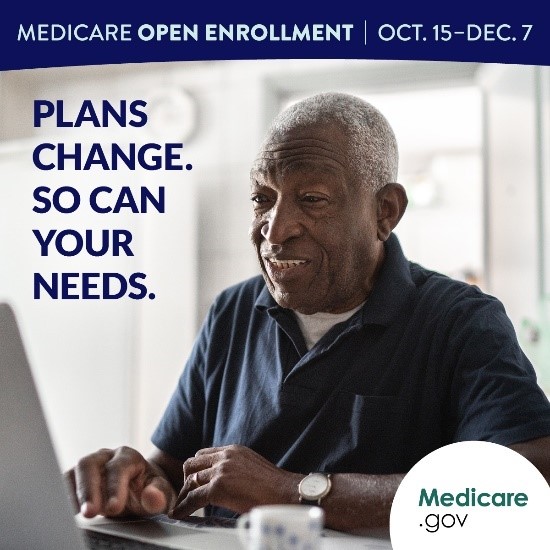November 12, 2021
Each fall, Medicare beneficiaries can review, compare, and change their coverage options during the Medicare Open Enrollment Period (OEP). The OEP, sometimes known as the annual election period, began on October 15 and ends on December 7. Changes made during the OEP affect coverage between January 1 and December 31, 2022. (The Medicare OEP is distinct from Health Insurance Marketplace Open Enrollment, which occurs November 1 through December 15.)
Medicare is integral to the economic security and health of people with disabilities and older adults. The type or types of coverage selected by beneficiaries can have profound effects on access to and cost of health care. Yet, Medicare enrollment can be challenging even for long-time beneficiaries and experienced care partners.
The Centers for Medicare & Medicaid Services (CMS) recommends that beneficiaries review coverage options each year because the needs of each beneficiary and the coverage offered by each plan often change. However, a 2021 Kaiser Family Foundation report found that seven of 10 beneficiaries did not compare coverage options during the 2018 OEP.
Moreover, the report found that this share was even higher among beneficiaries who (a) were Black or Latino, (b) had not attended college or vocational school, (c) were younger than 65 or older than 75, (d) had an income of less than $20,000 per year, (e) lived in a rural area, (f) reported their health status as “fair” or “poor,” and (g) were enrolled in Medicaid.
As a social worker, you can mitigate the challenges of open enrollment and help reduce Medicare-related disparities in multiple ways:
- helping clients to reassess their health needs—such as changes in their medications, health care providers, health condition, and necessary care—each year
- encouraging clients to read the Annual Notice of Change (sent each September), Evidence of Coverage, and other official information from their current plan or plans regarding changes forthcoming in 2022; helping clients distinguish this official Medicare mail from marketing ads
- providing unbiased information to clients about Medicare options and helping clients consider the implications of various enrollment options
- educating clients about Medicare OEP–related fraud, including deceitful sales tactics used by some Medicare Advantage Plans (sample consumer alerts: District of Columbia and Michigan)
- helping clients navigate the enrollment process via the Internet or telephone
- referring clients to reliable entities for additional assistance.
NASW’s 2020 Medicare OEP blog provided a brief overview of the Medicare program and OEP, along with links to multiple resources that can help you navigate the process for your clients, your family, or yourself. This blog describes broad changes that could affect beneficiary decision making during the OEP.
Language Access
CMS’s “Medicare & You” handbook is mailed to each beneficiary every September and constitutes a primary source of Medicare information for many beneficiaries.
The handbook, which is updated annually, is available for the first time this year in Chinese, Korean, and Vietnamese. These translations, for which NASW advocated earlier this year, improve access for Medicare beneficiaries. The handbook remains available in English and Spanish, including large-print and audio versions of both languages. It is also available in braille and in various e-book formats.
Accuracy of Information
This year’s edition of Medicare & You incorporates significant changes that provide a more balanced approach to the distinctions between original Medicare (also known as traditional Medicare; includes Parts A, B, and D) and Medicare Advantage (a privatized form of Medicare, often known as Part C). As noted in a special report published recently by the nonprofit Center for Medicare Advocacy (2021), “while there is still work to do, the new Handbook makes important strides towards reversing the bias in favor of MA that was prevalent in recent editions” (p. 1, para. 3).
NASW has advocated to reverse CMS’s growing bias toward Medicare Advantage, as a 2019 Practice Alert describes in detail. Consequently, the association applauds the changes in the 2021 handbook and hopes CMS will provide even more unbiased information in future editions of Medicare & You. However, a final rule released by the previous Administration weakened consumer protections regarding the marketing of Medicare Advantage plans, thereby creating even more confusion for beneficiaries—and the current Administration recently issued a memo to Medicare Advantage plans expressing concerns about plans’ misleading marketing practices.
Accurate information and valuable considerations regarding the distinctions between original Medicare and Medicare Advantage are available in another recent report published by the Center for Medicare Advocacy and in the Medicare Fully Informed Project, an initiative of the Center for Medicare Advocacy and the National Committee to Preserve Social Security and Medicare. (The latter resource includes a helpful Decision Tree infographic to help beneficiaries discern the appropriateness of original Medicare or Medicare Advantage for their individual circumstances.)
Another nonprofit organization providing unbiased information on Medicare options is the Medicare Rights Center (article; national helpline). NASW works closely with all three organizations in the Leadership Council of Aging Organizations (LCAO), which consistently upholds and works to strengthen original Medicare (among other areas).
Beneficiaries may also obtain unbiased information regarding Medicare options from the State Health Insurance Assistance Program (SHIP), which is funded by the Administration for Community Living (ACL, an operating division of the U.S. Department of Health and Human Services [HHS]). The final section of this blog provides details about accessing SHIP.
Part A and Part B Costs in 2022
Each year, CMS determines standard amounts most beneficiaries will pay out of pocket (OOP) for premiums, deductibles, and coinsurance in Part A and Part B. On November 12, CMS released a fact sheet announcing the following information for 2022:
- Part A premium: Many beneficiaries do not pay a premium for Part A. For those who do pay premiums, costs will increase by either $15 or $28 per month, as described in the fact sheet.
- Part A deductibles and coinsurance: Beneficiaries will incur the following increases: (a) $72 for the inpatient hospital deductible ($1,484 in 2021 and $1,556 in 2022), (b) $18 increase in daily coinsurance for the 61st through 90th inpatient hospital day (from $371 to $389), (c) $36 for each lifetime reserve day in an inpatient hospital ($742 to $778), and (d) $9 for skilled nursing facility coinsurance ($185.50 to $194.50).
- standard Part B premium: $170.10 per month , an increase of $21.60 from 2021; beneficiaries with high incomes pay more, as outlined in the fact sheet
- Part B annual deductible: $233 (an increase of $30)
Part D Costs in 2022
CMS has set the following standard rates for Part D (prescription drug coverage) in 2022:
- maximum Part D deductible a plan may charge: $480 (an increase of $35 as compared to 2021)
- limit for the initial coverage period (amount both the beneficiary and the Part D plan pay before the coverage gap begins): $4,430 (a $300 increase); each beneficiary’s “true OOP costs” for the initial coverage period and the coverage gap may not exceed $1,107.50 and $5,582.50, respectively
- threshold for the catastrophic coverage period (point at which OOP costs for most beneficiaries decrease dramatically until the next calendar year begins): $7,050 (a $500 increase).
Although the donut hole officially closed in 2021, OOP costs remain confusing for many beneficiaries. The Medicare Part D Cost-Sharing Chart developed by the National Council on Aging (another LCAO member with which NASW works closely) provides detailed descriptions of each coverage period and associated OOP costs.
CMS has projected that the average monthly premium for Part D plans will be about $33 in 2022, an increase of $1.47 as compared to 2021. However, premiums vary widely and are based on a variety of factors, including geography, deductible amount, copayment amounts, plan formulary, and beneficiary income. (CMS’s November 12 fact sheet lists the increases in Part D income-related adjustment amounts, also known as “IRMAA,” for beneficiaries with high incomes.) Furthermore, CMS has published fact sheets regarding the Part D landscape for each state and for the District of Columbia, American Samoa, Guam, Northern Mariana Islands, Puerto Rico, and the U.S. Virgin Islands. Each fact sheet provides information regarding the availability of, and average premium costs for, Part D plans in the given state or jurisdiction. Each fact sheet also includes Medicare open enrollment dates and resources.
Medicare Advantage Costs in 2022
CMS has projected that the average monthly premium for Medicare Advantage plans will be $19 per month in 2022. Moreover, the CMS Part D fact sheets include facts about the Medicare Advantage landscape (availability of plans and average premium costs) for each state and for the District of Columbia and Puerto Rico.
Financial Assistance for Medicare Beneficiaries
Various government-funded programs exist to assist beneficiaries with limited financial means:
- Medicare Savings Programs (MSPs)—Four Medicaid-administered programs help cover OOP costs of Medicare premiums (Part A, if applicable, and Part B), deductibles, copayments, coinsurance, or some combination of these. MSPs are available to beneficiaries who live in the District of Columbia or the 50 states. Free screening for MSP eligibility is available through SHIP sites and state Medicaid offices.
- Low Income Subsidy, also known as “LIS” or “Extra Help”—This program, administered by the Social Security Administration in coordination with CMS, helps cover Part D premiums, deductibles, copayments, or some combination of these OOP costs. Medicare beneficiaries who are enrolled in an MSP, Medicaid, or Supplemental Security Income are automatically screened for LIS eligibility. Other beneficiaries may contact the Social Security Administration or their local SHIP. LIS is available to beneficiaries who live in the District of Columbia or the 50 states.
- State Pharmaceutical Assistance Programs (SPAPs)—Assistance available through SPAPs vary. As of 2020, these programs were available in the U.S. Virgin Islands and 15 states. SHIP sites maintain information regarding current availability.
- AIDS Drug Assistance Program (ADAP)—ADAP provides HIV-related prescription drug assistance to people living with HIV/AIDS whose prescription drug coverage is limited or nonexistent. The program is funded by the Ryan White HIV/AIDS Program, which is administered by the Health Resources and Services Administration (an operating division of HHS). The privately funded ADAP Directory provides information about programs in all 50 states, the District of Columbia, American Samoa, Federated States of Micronesia, Guam, Marshall Islands, Northern Mariana Islands, Palau, Puerto Rico, U.S. Virgin Islands, and Wake Island. This directory also includes links to other entities that assist consumers in paying for medications.
In addition to the previously named resources, a national network of more than 80 Benefits Enrollment Centers (funded in part by ACL and supported by the National Council on Aging) assists beneficiaries in determining eligibility and applying for MSPs and LIS.
Enrollment Tools and Additional Information
The Medicare Plan Finder is a CMS tool to help beneficiaries compare and enroll in Medicare Part D plans and Medicare Advantage plans. For these types of plans, a “Plan Details” button directs users to each plan’s type, identification number, Web site, and phone number (in the event a user should desire additional information). An “Enroll” button enables the beneficiary to enroll directly through the Plan Finder. The Plan Finder also includes information about finding, distinguishing, and enrolling in plans for Medicare supplemental insurance (“Medigap”) and the Program of All-Inclusive Care of the Elderly (PACE). However, the Plan Finder does not enable beneficiaries to enroll in Medigap or PACE, as it does in Part D or Medicare Advantage. Instead, the Plan Finder directs users to individual plan sites both for details and for enrollment.
CMS has updated the Plan Finder for use during the OEP. Learn about these changes and other OEP details by reading the transcript for or observing one of the following free Webinars:
- CMS—National Medicare Education Program Webinar (September 8, 2021) and National Training Program Webinar (September 30, 2021)
- Center for Medicare Advocacy—Medicare Enrollment Issues for 2022 (October 20, 2021)
- National Council on Aging—Medicare in 2022.
Additionally, CMS provides downloadable outreach and media materials to help social workers and other service providers promote the Medicare OEP.
Beneficiaries who seek do not have Internet access or who wish to talk with a CMS representative may call 1-800-MEDICARE (1-800-633-4227). TTY users may call 1‑887-486-2048. Beneficiaries may also interact with CMS representatives via Medicare.gov Live Chat. Telephone and TTY access are both available 24 hours per day, seven days per week. Live Chat is available at the same frequency, except on some federal holidays.
Beneficiaries who seek additional support during the Medicare OEP may contact their local SHIP. SHIP sites are equipped to serve beneficiaries remotely during the COVID-19 pandemic. However, availability of remote and in-person assistance may vary based on location and beneficiary need. SHIP sites exist in all 50 states, the District of Columbia, Guam, Puerto Rico, and the U.S. Virgin Islands. To find a SHIP site in your state or jurisdiction, visit the SHIP Locator or call 1-877-839-2675.
Key Resources
- Medicare Plan Finder (CMS)
- SHIP (ACL)
- Center for Medicare Advocacy
- Medicare Rights Center
- National Council on Aging
By Chris Herman, MSW, LICSW – Senior Practice Associate, Aging, NASW




